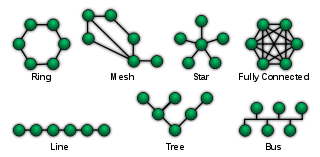Related Research Articles

The Semantic Web, sometimes known as Web 3.0, is an extension of the World Wide Web through standards set by the World Wide Web Consortium (W3C). The goal of the Semantic Web is to make Internet data machine-readable.

Extensible Markup Language (XML) is a markup language and file format for storing, transmitting, and reconstructing arbitrary data. It defines a set of rules for encoding documents in a format that is both human-readable and machine-readable. The World Wide Web Consortium's XML 1.0 Specification of 1998 and several other related specifications—all of them free open standards—define XML.
A disk image is a snapshot of a storage device's structure and data typically stored in one or more computer files on another storage device. Traditionally, disk images were bit-by-bit copies of every sector on a hard disk often created for digital forensic purposes, but it is now common to only copy allocated data to reduce storage space. Compression and deduplication are commonly used to reduce the size of the image file set. Disk imaging is done for a variety of purposes including digital forensics, cloud computing, system administration, as part of a backup strategy, and legacy emulation as part of a digital preservation strategy. Disk images can be made in a variety of formats depending on the purpose. Virtual disk images are intended to be used for cloud computing, ISO images are intended to emulate optical media and raw disk images are used for forensic purposes. Proprietary formats are typically used by disk imaging software. Despite the benefits of disk imaging the storage costs can be high, management can be difficult and they can be time consuming to create.
XSD, a recommendation of the World Wide Web Consortium (W3C), specifies how to formally describe the elements in an Extensible Markup Language (XML) document. It can be used by programmers to verify each piece of item content in a document, to assure it adheres to the description of the element it is placed in.

Computer forensics is a branch of digital forensic science pertaining to evidence found in computers and digital storage media. The goal of computer forensics is to examine digital media in a forensically sound manner with the aim of identifying, preserving, recovering, analyzing and presenting facts and opinions about the digital information.
An XML schema is a description of a type of XML document, typically expressed in terms of constraints on the structure and content of documents of that type, above and beyond the basic syntactical constraints imposed by XML itself. These constraints are generally expressed using some combination of grammatical rules governing the order of elements, Boolean predicates that the content must satisfy, data types governing the content of elements and attributes, and more specialized rules such as uniqueness and referential integrity constraints.

Simson L. Garfinkel is the chief scientist of BasisTech in Somerville, Massachusetts. He was previously a program scientist at AI2050, part of Schmidt Futures. He has held several roles across government, including a Senior Data Scientist at the Department of Homeland Security, the US Census Bureau's Senior Computer Scientist for Confidentiality and Data Access and a computer scientist at the National Institute of Standards and Technology. From 2006 to 2015, he was an associate professor at the Naval Postgraduate School in Monterey, California. In addition to his research, Garfinkel is a journalist, an entrepreneur and an inventor; his work is generally concerned with computer security, privacy and information technology.
NIEMOpen, frequently referred to as NIEM, originated as an XML-based information exchange framework from the United States, but has transitioned to an OASISOpen Project. This initiative formalizes NIEM's designation as an official standard in national and international policy and procurement. NIEMOpen's Project Governing Board recently approved the first standard under this new project; the Conformance Targets Attribute Specification (CTAS) Version 3.0. A full collection of NIEMOpen standards are anticipated by end of year 2024.
Sitemaps is a protocol in XML format meant for a webmaster to inform search engines about URLs on a website that are available for web crawling. It allows webmasters to include additional information about each URL: when it was last updated, how often it changes, and how important it is in relation to other URLs of the site. This allows search engines to crawl the site more efficiently and to find URLs that may be isolated from the rest of the site's content. The Sitemaps protocol is a URL inclusion protocol and complements robots.txt, a URL exclusion protocol.

The Oxygen XML Editor is a multi-platform XML editor, XSLT/XQuery debugger and profiler with Unicode support. It is a Java application so it can run in Windows, Mac OS X, and Linux. It also has a version that can run as an Eclipse plugin.
Sandstorm Enterprises was an American computer security software vendor founded in 1998 by Simson Garfinkel, James van Bokkelen, Gene Spafford, Dan Geer. In January 2010, it was purchased by NIKSUN, Inc.
XML validation is the process of checking a document written in XML to confirm that it is both well-formed and also "valid" in that it follows a defined structure. A well-formed document follows the basic syntactic rules of XML, which are the same for all XML documents. A valid document also respects the rules dictated by a particular DTD or XML schema. Automated tools – validators – can perform well-formedness tests and many other validation tests, but not those that require human judgement, such as correct application of a schema to a data set.
Extensible Forms Description Language (XFDL) is a high-level computer language that facilitates defining a form as a single, stand-alone object using elements and attributes from the Extensible Markup Language (XML). Technically, it is a class of XML originally specified in a World Wide Web Consortium (W3C) Note. See Specifications below for links to the current versions of XFDL. XFDL It offers precise control over form layout, permitting replacement of existing business/government forms with electronic documents in a human-readable, open standard.

Network forensics is a sub-branch of digital forensics relating to the monitoring and analysis of computer network traffic for the purposes of information gathering, legal evidence, or intrusion detection. Unlike other areas of digital forensics, network investigations deal with volatile and dynamic information. Network traffic is transmitted and then lost, so network forensics is often a pro-active investigation.
File carving is the process of reassembling computer files from fragments in the absence of filesystem metadata.
Plazi is a Swiss-based international non-profit association supporting and promoting the development of persistent and openly accessible digital bio-taxonomic literature. Plazi is cofounder of the Biodiversity Literature Repository and is maintaining this digital taxonomic literature repository at Zenodo to provide access to FAIR data converted from taxonomic publications using the TreatmentBank service, enhances submitted taxonomic treatments by creating a version in the XML format Taxpub, and educates about the importance of maintaining open access to scientific discourse and data. It is a contributor to the evolving e-taxonomy in the field of Biodiversity Informatics.
Photo recovery is the process of salvaging digital photographs from damaged, failed, corrupted, or inaccessible secondary storage media when it cannot be accessed normally. Photo recovery can be considered a subset of the overall data recovery field.
The following is provided as an overview of and topical guide to databases:
A machine-readable document is a document whose content can be readily processed by computers. Such documents are distinguished from more general machine-readable data by virtue of having further structure to provide the necessary context to support the business processes for which they are created.
References
- Simson Garfinkel, Digital Forensics XML and the DFXML toolset, Digital Investigation, 2012.
- Simson L. Garfinkel, Automating Disk Forensic Processing with SleuthKit, XML and Python, Systematic Approaches to Digital Forensics Engineering (IEEE/SADFE 2009), Oakland, California. (Acceptance rate: 32%, 7/22)